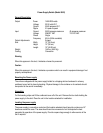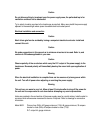Xenon lamp power supplies have two stages of operation:
1) Before igniting the bulb – At this time, the voltage at the power supply output terminals
reaches “open circuit” value (110 VDC or greater).
2) After igniting the bulb – At this time, the voltage at the power supply output is determined
by the load placed on the power supply by the xenon lamp (18-30 VDC).
Power supply difficulties can be separated into one of three areas for purposes of diagnosis and
repair:
A) Power line problems.
B) Boost circuit (Open circuit voltage) problems.
C) Main power supply problems.
A) Primary power problems
Power to the power supply is supplied from the sub-panel. The PSU power contactor, K1, will
operate when the lamphouse is switched on in the absence of primary power to K1. If there is D.C.
voltage out of the power supply as indicted on the lamphouse voltmeter you have primary power. If
there is no lamphouse voltmeter, use your VOM. If there is no DC. output voltage and K1 operates,
check the primary line with a VOM to locate the point of failure.
B) Boost circuit problems (open circuit voltage)
Loss of the open circuit voltage due to boost circuit problems will result in the following:
Ignitor will not fire in the AUTO mode.
Bulb will not light.
Disable the lamphouse ignitor by removing primary power to the ignitor. Connect your VOM to the
power supply D.C. output. Observe polarity. Turn on the power supply. If you read 110 VDC or
more, the boost circuit is operating. If the D.C. voltage is low, on the order of 50 volts, it is likely
that diodes 5 and/or 6 have failed. Current limiting resistor R1 may be open.
C) Main power supply
Power supply bank D1-D4
A shorted diode will cause the primary current to go high and will trip the circuit breaker in the sub-
panel. An open diode will cause the projected picture to have a pronounced flicker and may result
in somewhat lower operating current.
Capacitors C1-C2-C3
A shorted capacitor or capacitors will raise the primary current and trip the circuit breaker in the
sub-panel.
C1-C2-C3
If these are open or have lost capacity (ability to store energy) they will cause either a noticeable
flicker in the projected picture or ignition problems or both. If in doubt, disconnect the capacitors
one at a time. After disconnecting a capacitor, if no change in ignition or flicker is observed, then
the capacitor is having no effect. Replace it.


















